He is a beloved leader for many Russians to this day. For other nations - a bloody executioner, although there was a time when the West looked for an ally in him. Much has been written about the life and crimes of the "Red Tsar". We still haven't learned all of Stalin's secrets.
Although he avoided death many times as a young child, his childhood was happy. Propaganda was that he loved children. Maybe even too much ... But that didn't stop him from sending the youngest to labor camps.
The adult Josif Vissarionovich Dzhugashvili came to the top thanks to a lie, led to the death of millions, and finally became his last victim himself. Learn surprising facts from the life of the Soviet dictator.
All items in the list are based on our articles.
Did you know that…
10. ... Stalin miraculously escaped death many times as a child?
If cats are said to have nine lives, what about Stalin? He first slipped out from under the grim reaper's scythe when he was just a baby. We don't know exactly what he was ill with, but his parents feared he would share the fate of two older brothers who died before their first year.
As a few years old he suffered from smallpox, malaria, and an accident that ended with muscle atrophy of his left hand. He fell under a speeding carriage at the age of twelve, and soon became seriously ill with pneumonia.
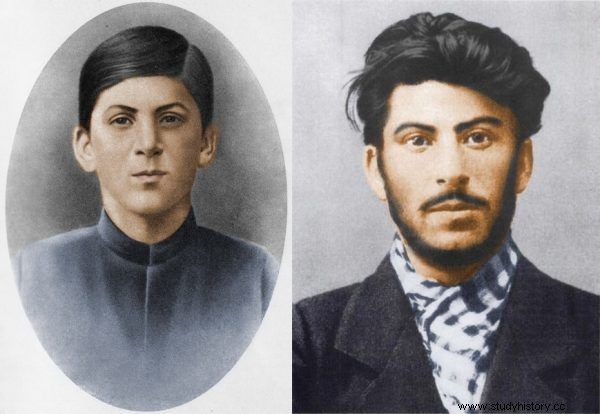
The fact that Stalin lived to be a teenager could be called a miracle. Were it not for what use he made of his miraculously saved life ... (source:public domain).
Looking at the realities of medical care at that time, which a young Georgian could count on, it must be said:the fact that he lived to adulthood was a real miracle. Though for the millions of its victims it would probably be better if it hadn't happened.
These are not all the diseases that struck Joseph Stalin. The dictator's lifestyle contributed to the development of atherosclerosis, tonsillitis, viral hepatitis and many other diseases. It is legitimate to discuss whether bad health had an impact on Dzhugashvili's cruelty, extreme distrust and paranoid behavior ... (read more on this topic).
9. ... in fact Stalin was a modest man?
At least such conclusions can be drawn by analyzing history and giving him the title of generalissimo. The idea did not come from the dictator himself, but from Marshal Koniew. Stalin did not feel pleasantly tickled at all, or at least he did not show it. Apparently, he waved his hand, suggesting that he was too old and "what is it for?".
Józef's bodyguards did not give up. Malenkov and Beria themselves led to the awarding of a new title and the award of the leader with the Golden Star of the Hero of the Soviet Union.
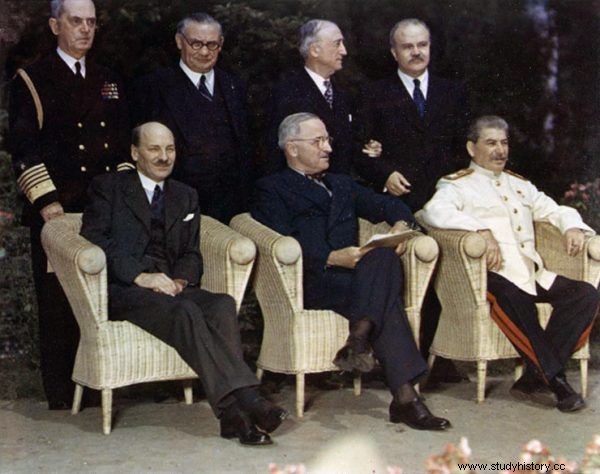
The white jacket and trousers with stripes against the elegant black of the other Potsdam conference participants looked kitschy enough. But Stalin probably congratulated himself for not agreeing to the gilded uniform ... (source:public domain).
How did the distinguished person react? He was furious! He refused to accept the medal as he did not take part in the struggle on the battlefield personally.
Although he eventually retained the title of generalissimo, he rejected the idea of renaming Moscow as Stalinodar, for example. He also did not want to parade in a specially crafted gilded uniform with a golden cap, which was to be in keeping with his new dignity. He asked the tailor to sew something more modest (read more about it).
8. …. Stalin could have up to 100 million victims on his conscience?
It is hard to believe, but so much goes out of the accounts when you collect all the victims who lost their lives as a result of the Soviet dictator's decision. Of course, some numbers are debatable, but one thing is certain - Józef Wissarionowicz Stalin has several times more human lives on his conscience than Adolf Hitler.
First, the Gulag. A system of labor camps that, according to Alexander Solzhenitsyn's estimates, took the lives of 60 million people. To this must be added the Great Famine in Ukraine with six million starving victims, the Polish NKVD operation carried out during the Great Terror (200,000), the crime in Katyn (22,000) and so on and so on ...
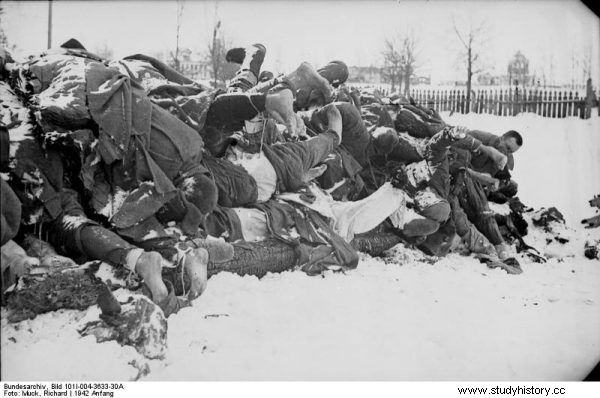
Cruelty and contempt for human life - these qualities made Stalin one of the greatest criminals in history. In the picture:Red Army soldiers died. Photo from 1942 (source:Bundesarchiv; photo:Richard Muck; license CC-BY-SA 3.0).
Stalin should also be credited with the 27 million victims of World War II on the Soviet side. It may be controversial, but it was the Molotov-Ribbentrop Pact that caused it to explode!
The number of deaths would also be smaller, if not for Stalin's contempt for the life of his soldiers, manifested in irrational decisions, sending entire units to certain death, lack of provisions, clothes, weapons ... (read more on this topic).
7. ... Joseph Stalin might have been a pedophile?
The red tsar had two wives. One died of tuberculosis, the other committed suicide. But the story of the bloody dictator's sex life does not end there.
Among the numerous conquests of Stalin there were also very young girls, almost children. Does this prove that Stalin was a pedophile? Well, we certainly are not going to call the normal romance of a grown man who buried his first wife six years earlier with a thirteen-year-old! In addition, the girl became pregnant with Stalin. More than once!
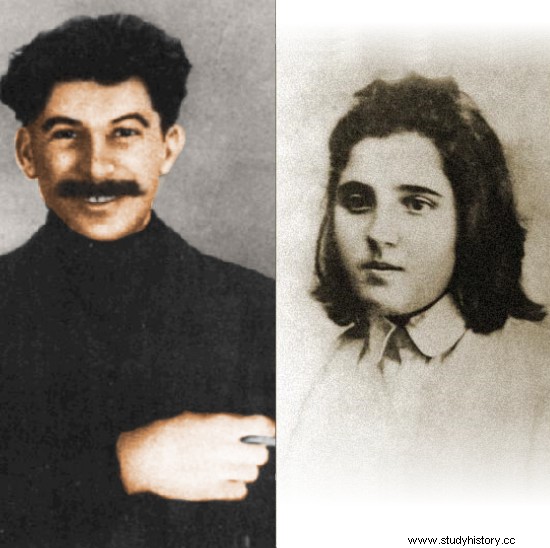
When the love flared up, Stalin was 40, and Nadia was 16. In the photos:Stalin at 37, Nadia - 17. Woman or child? (source:public domain)
A similar age disproportion also appeared in the relationship with the second wife. When the romance began, Nadia was sixteen, Koba was forty. He saw the girl for the first time when she was ten. Did it catch his eye already then?
Stalin operated under the patent of a "dirty uncle" - he met both young people with whom he had an affair as "a friend of the family". We also know that he was hitting on other schoolgirls, and as a dictator, he invited young Komsomol women to his dacha.
As Diane Ducret, the author of "Women Dictators" wrote about him: He does not trust women as strong and intelligent as his mother. (...) Knowing the steadfastness of this type of women, throughout his life he preferred young people, susceptible to the influence of teenage girls. (read more about it).
This article has more than one page. Please select another one below to continue reading.Attention! You are not on the first page of the article. If you want to read from the beginning click here.
6. ... the death of Joseph Stalin was in fact ... Joseph Stalin?
On March 1, 1953, Stalin stayed in his rooms all day after a well-drunk supper with the most trusted people. But no one dared find out what was happening to the dictator.
Only in the evening one of the bodyguards found the chief on the floor in a pool of his own urine. If someone else lay so helplessly, an emergency action would probably be organized immediately, a doctor was called, and resuscitation began. In such situations, you have to act quickly, decisions have to be made immediately.
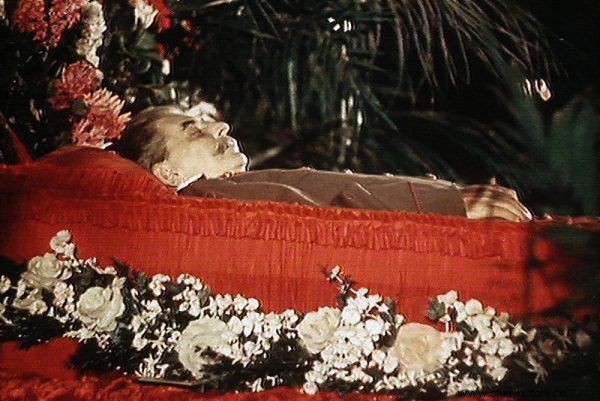
"Mediocre, passive, but faithful" - surrounding oneself with such people may and has some advantages, but not when we are threatened with death and we need quick, decisive action ... Still from the movie "Death of Stalin - the end of the epoch".
But the entire entourage of Stalin was effectively castrated on all initiatives. The notified minister of security was afraid to make any decisions on his own. Malenkov, before taking any steps, had to contact Beria, Khrushchev and Bulganin. Nobody wanted to take responsibility for the obvious decision to call a doctor.
It was only among a dozen or so people from the Presidium of the Central Committee that the courage to send medical assistance to the Generalissimo was made. It was already March 2 and the rescue had arrived too late. The red tsar's agony continued for three more days. Perhaps the reaction would have been faster had it not been for the earlier purges, the paranoia of the doctors' conspiracy and Stalin's tendency to surround himself with utter mediocrity (read more on this).
5. … Vodka helped him to reach the top of power?
After Lenin's death, the "throne" of the proletarian homeland waited for a new "tsar". Lev Trotsky was preparing for the role of the leader of the Soviet Union. Like Lenin, he was an implacable opponent of alcohol.
To develop, consolidate and crown the anti-alcohol regime in the country of the resurgent working class - that is our task! - thundered at a meeting of the Central Committee in 1923.
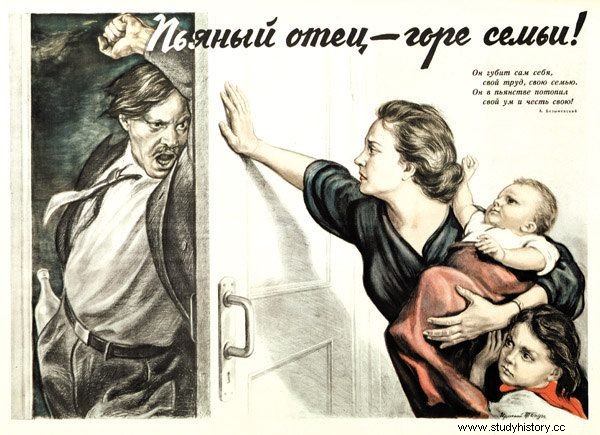
The poster may be suggestive, "drunk father" may and indeed is "a misfortune for the family", but to ban alcohol completely? People couldn't like it. And Stalin knew about it
The power-hungry Stalin had a different view of these matters. He strove to end Prohibition. The goal was purely pragmatic - to support the state budget. But by the way, he managed to arouse the love of the Soviet people who did not want to live without vodka.
On the road to success, he did not shy away from lying. Trotsky's opposition to alcohol was based on the opinion of Lenin, adored by all. To neutralize this argument, Stalin ... came up with a conversation with the leader of the revolution, in which he allegedly emphasized the necessity of introducing a vodka monopoly.
It turned out that it was Dzhugashvili who better understood the needs of the working-class and peasant masses. Huge popularity helped to gain power. And vodka became his ally in another fight - with Nazi Germany (read more about this).
4. … Little Soso actually had a happy childhood?
An alcoholic father, domestic violence - many people believe that the childhood of the future dictator was hell. However, the Russian historian Oleg Khlevniuk proves that in fact Stalin's youngest years were quite happy
First of all, he had an extremely loving and dedicated mother. Besides, with the support of family friends, they did not fare too badly. Iosef was even the best dressed boy in school!
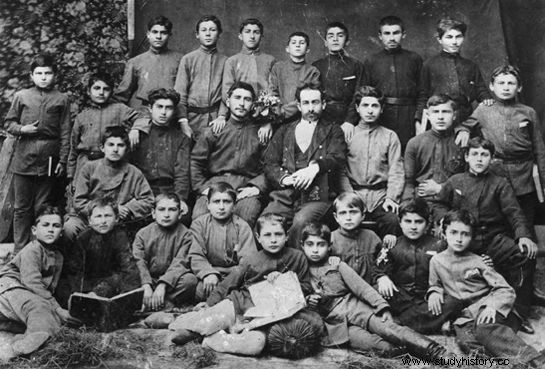
Ten-year-old Soso's class. The later dictator in the top center row (source:public domain).
Secondly, despite his illnesses and a disabled hand, he was by no means an outcast among his peers. On the contrary, he enjoyed the sympathy of his surroundings and even earned his respect by taking part in street fights and wandering around Gori with similar little rascals.
The historian proves that it is not in his sad childhood that the cause of Stalin's later cruelty should be sought. If at all such easy excuses make sense in his case (read more about that).
This article has more than one page. Please select another one below to continue reading.Attention! You are not on the first page of the article. If you want to read from the beginning click here.
3. ... hundreds of thousands of Stalin's soldiers betrayed him to Hitler?
Stalin was truly paranoid. Betrayal, both real and presumed, he never forgave. It is well known that he treated all soldiers who were captured by the Germans as sellers and agents.
But it is not so well-known anymore that many of them actually changed colors and fought alongside Hitler's army. And there is no reason to be surprised! Would they remain faithful, or have they gone over to the enemy's side, in Russia a bullet to the head was waiting for them anyway.
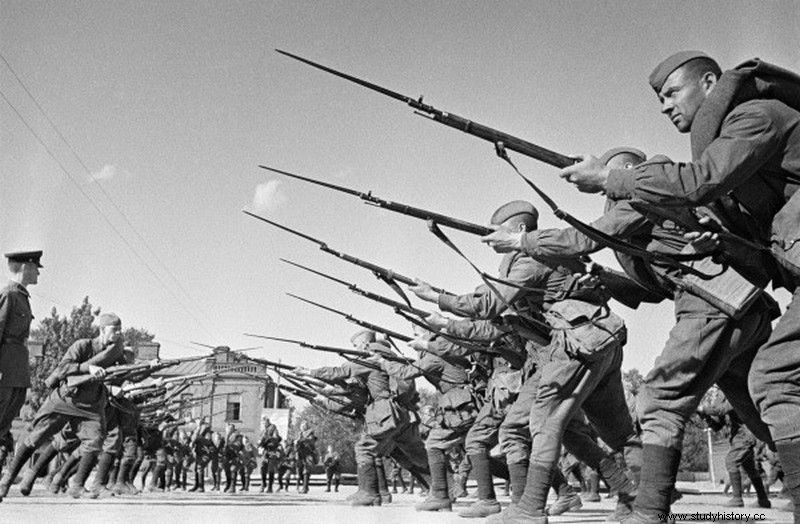
The failure of the Soviet Union to adopt the convention on the protection of prisoners of war was used by the Germans, who killed hundreds of thousands of the captured Red Army soldiers (source:RIA Novosti archive; lic. CC ASA 3.0).
Yet another fact drove Soviet soldiers into the arms of the Nazis. The Soviet Union refused to recognize the 1929 Red Cross convention. As a result, the captured Red Army soldiers did not have the status of prisoners of war.
One of such soldiers, Lieutenant Borisov, argued that:
They, in the Kremlin, released the Germans themselves from responsibility for our lives. So Germany is our enemy? If they are enemies of Stalin and his gangs, then they are my allies.
Many other Soviet citizens, who could not count on a warm welcome upon returning to their proletarian homeland, thought similarly. In order not to starve in captivity, they decided to join the ranks of recent enemies (read more about this).
2. ... Stalin sent even children several years old to labor camps?
The Gulag is not only prisons and labor camps. These are also NKVD orphanages, special orphanages and centers for the Soviet street children. Children of the "enemies of the people", such as the ten-year-old Pole at the time, Alina Vincenz, also found their way to such places.
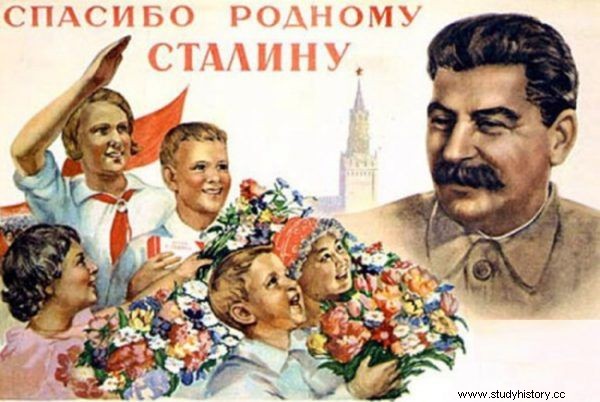
Children thank Stalin for a happy childhood ... Soviet propaganda poster.
Although the conditions in centers for children were much better than in "adult" camps, for a girl from a good home, like little Alina, it was a tough school of life. The feeding of juvenile labor camps was relatively good, but this only provoked the "guardians" to take the delicacies for themselves and forcing them to obey with brutal beatings.
Alina was lucky - she survived, and after a long battle, she reunited with her mother, who was also in one of the camps. Other children died in labor camps or stayed in them even after reaching the age of majority, forgetting the language, parents, their own name. It was all because of Stalin, who loved children so much… (read more about it).
1. ... Stalin wanted to create a proletarian paradise on earth for the Poles in the Soviet Union?
And that's right before he decided to murder them all. We turned out to be too grateful?
On the wave of corrosion, that is, the new national policy, the Soviet Union began to focus on the cultural development of individual nations. It was supposed to win the sympathy of the people and help spread their propaganda - the working-class and peasant masses, able to read, could finally understand what the Bolshevik pamphlets and posters said.
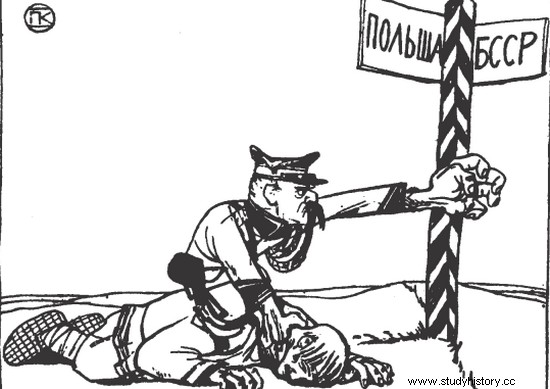
As part of Polish autonomy, the Polish-language press appeared in the Soviet Union. It was a tool of Bolshevik propaganda, which at every step presented the threat from the "fascist" side of the Second Polish Republic. The illustration shows a caricature in one of the issues of "Orka". Illustration from the book by Nikolai Ivanov, Forgotten Genocide. Poles in the state of Stalin. »Polish Operation« 1937–1938 ″ (Znak Horyzont 2015).
Poles were also to benefit from it. For example, in July 1926, the Polish National Region was established in Volhynia. Julian Marchlewski, which instead of becoming an idyllic place of prosperity, with schools, industry, hospital, power plant ... 80-90 percent of the district's budget came from the central budget.
These proletarian paradises were to show the capitalist neighbors how wonderful life is in the Soviet Union. Nothing was that it was just makeshift, and the level of local education, the press and theaters was embarrassingly low (read more about it).
